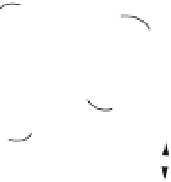Geography Reference
In-Depth Information
Video projector
polarizer filter
d
CCD camera
Polarizer filter
h
p
h
CCD
Calibration board
Computer controlled
water flow and
sediment feeding
α
2
I
C
I
p
O
Reference plane
1
β
Stream table
θ
Overflowing
tank
Balance
Figure 13.18
Setup of experiment with a moire projection method to study microscale braided channels at the IPGP experimental
geomorphology laboratory (Limare et al., 2011).
maximum water depth was approximately 3 mm (flow
depth increases in the negative direction).
Flow depths were systematically filtered to remove
noise by analysing the PDF of flow depths for the entire
study area. Average flow depth was -0.24 mm with a
standard deviation of 0.43 mm respectively. We consid-
ered positive flow depth to be noise and assumed noise
to be symmetrical around zero. Noise was subtracted
from the original distribution to obtain a 'real' distribu-
tion of depths which had a mean and standard deviation
of -0.49 mm and 0.41 mm respectively. The area of the
flume occupied by flow after noise correction was 49%,
which corresponds well with visual observations.
i
c
i
p
h
r
p
H
r
c
Δ
h
13.5 Conclusions
Figure 13.19
Light refraction into a layer of water (Limare
et al., 2011).
We have presented several imaging techniques used to
study rivers in laboratory experiments and shown how
these techniques provide efficient non-laborious means
of acquiring high resolution data that enable researchers
to describe the evolution and organisation of experimen-
tal rivers and deltas with increasingly robust statistics.
Imaging techniques in the laboratory benefit from the
high degree of control over lighting and colour of mate-
rials. The quality of the data collected using any imaging
technique are optimised if the requirements of a given
technique are considered in advance and implemented in
depth was calculated by subtracting dry topography from
wet topography taking into account water refraction and
incidence angle as described above. The impact of stop-
ping and restarting the flow on the bed topography was
negligible. Figure 13.20 shows (a) bed topography and
(b) flow depth along a cross-section approximately 0.5 m
mid-way down the study reach. Several occupied and
abandoned channels can be depicted along this tran-
sect. Dry bed topography in these microscale experiments
ranged from -4 to
+
4 mm relative to the initial flat bed,

















Search WWH ::

Custom Search